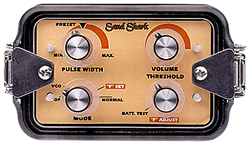This is an old post, but what the hey...
I have one.
If you buy one your best bet is to run it in all-metal by hitting the P/P button and making it run with threshold tone in all-metal. It will likely be rather soft in volume when held still. It has a slow re-tune rate to threshold. Then watch the screen ID when you hear the tone when searching. It is only a single tone, but when run as I described, you (could) gain up to an extra 3" more (air) depth than in disc, or at least 1" more in the ground, depending on where you search, and how it is internally ground-balanced. If it already had an external GB, it is capable of 13" on a dime (in air) and 14" on a nickel (in air). Mine does. In the ground all the rules change, and so does the depth results, just like any other detector, including PI's.
You should check to see if it needs some internal ground balance adjustments before you buy it. Here is how: Check to see if it bellows or gets quiet nearing the ground in P/P mode with its slight tone, because if doing that and it gets loud real easily, you would have to adjust the internal ground balance pot inside it to match your soil. Yes, someone could put in an exterior GB pot for you, and an external sensitivity adjustment too, but it wouldn't be worth the time and money. Similarly, if that threshold tone goes quiet instead, the same thing will be required. It is not a good cherry picker, in fact, it sucks. I bought mine for open fields and salt/black sand beaches because it has a very wide scan. Sensitivity: Turn the sensitivity to just where it stops getting interference (AKA noise). It's no Minelab Sov GT, but it will work there if it works here, but again it will likely need some readjustments of its internal potentiometers, count on it. If you are new at the game, I personally would pass on it. If not, then it's sort of a gamble. And if you understand how to calibrate electronics, it's a simple walk in the park with a beer in your hand.







